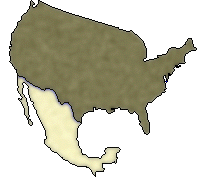The United States and Mexico share more
than 2000 miles of common border. More than nine million
people live in the border area, mostly in fifteen
"sister city" pairs. The rapid increase in
population and industrialization in the border cities has
overwhelmed existing wastewater treatment, drinking water
supply, and solid waste disposal facilities. Untreated
and industrial sewage often flows north into the U.S.
from Tijuana, Mexicali, and Nogales, and into the Rio
Grande.
Some 300,000 people on the U.S. side of the border also lack safe drinking water, wastewater
collection and treatment systems, or adequate solid waste disposal facilities. They live in
unincorporated areas called "colonias." Over 1,200 colonias have been identified in Texas and
New Mexico. EPA grants to the states, matched by state resources, provide for construction of
wastewater and drinking water facilities in these communities. Thus far, $320 million has been
appropriated by Congress for this program. For more information on the colonias, please visit the Texas Water Development Board web site. ![]()
As part of the Administration's efforts to implement the North American Free Trade Agreement (NAFTA), EPA is working with other Federal, State, and local agencies to help find and fix environmental problems on the border. Some $8 billion in a mix from Federal, State, local, and private-sector finding will be required to adequately protect public health and the border ecosystem.
OWM's border development activities include:
- Identification of border communities needs, and help in meeting those needs;
- Grants for funding of wastewater treatment construction in the colonias and elsewhere on the border;
- Helping improve environmental information collection on the border; and
- Providing technical assistance and training to officials and border residents.
EPA will continue working to improve environmental conditions along the border. The Agency has opened offices in the proximity of the border at El Paso and San Diego to provide information on EPA programs of interest to border residents. EPA works closely with the Border Environment Cooperation Commission and the North American Development Bank to evaluate environmental needs and to facilitate the construction of environmental infrastructure.
 |
|
You will need Adobe Acrobat Reader to view a number of Adobe PDF documents. Click here to read About Portable Document Format Files.
![[logo] US EPA](https://webarchive.library.unt.edu/eot2008/20090116013811im_/http://www.epa.gov/epafiles/images/logo_epaseal.gif)